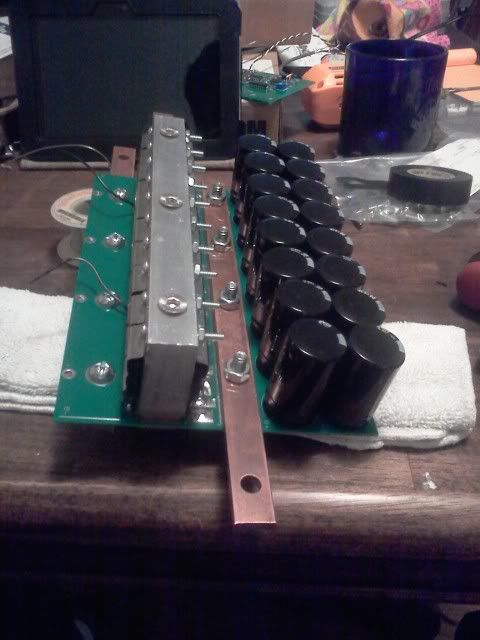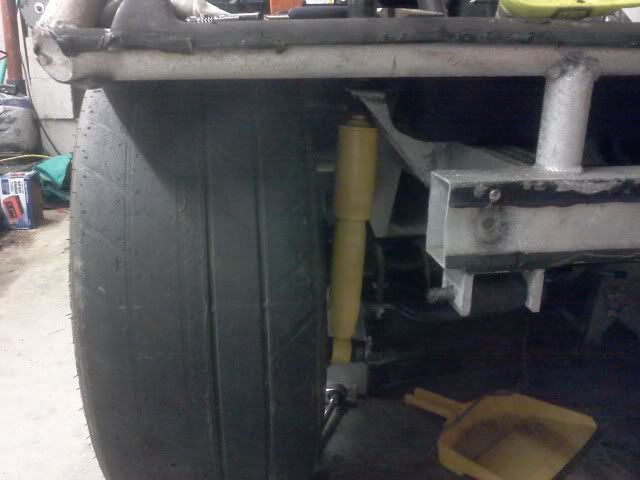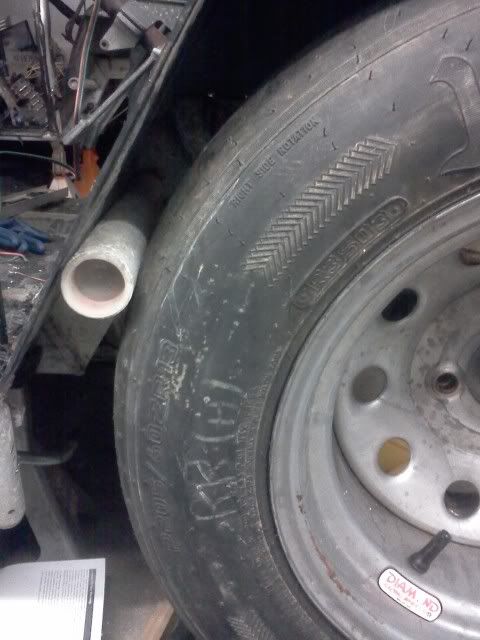The MK1 focus had an inertia kill in the passenger foot well. I'm not quite sure how to adapt one, but I do know that a particularly big pothole would trip it. Just push to reset.
The MK1 focus had an inertia kill in the passenger foot well. I'm not quite sure how to adapt one, but I do know that a particularly big pothole would trip it. Just push to reset.
MrJoshua wrote: Bryce. Mine are living the OEM style above 20 percent below 80 percent charmed life. Each cell group voltage was monitored before, during, and after charging an each stayed within .01 Volts of each other. I am the BMS and will likely be seen crawling around the car with a multimeter before and after every run. NEDRA outlines the NHRA EV specific safety regs and I will be following those to the letter.
Just remember that the problems with under and over voltage happen when you're USING the battery (discharge or charge), not when you're stationary. That's the whole point of battery monitoring/management, it tracks things when you can't (easily).
MrJoshua wrote: In reply to Nashco: Bryce, Does that mean you are coming to the challenge? Cool! There is one part I don't think I have around: an inertia switch. What did you use in yours? I keep remembering that my Land Rover had one but I think all the electrons would just refuse to come out of the battery if I put a Lucas switch in the safety circuit.BTW-in most cases I've seen the OEM's treat their batteries very very poorly. I need to read up on how Nissan is handling it with the Leaf.
I don't know if I'm coming...I'd like to, but can't justify shelling out a ton of money for a room at the host hotel just for me. If you can't find a cheap inertia switch, don't go without...I can provide one. However, first things first your local junkyard should be chock full of them as they've been used on tons of cars over the years (such as 90s Fords, typically in the trunk on sedans). Here are some new part numbers found on rockauto.com as a reference (you can use this to find vehicle applications, then find those vehicles in the junkyard and get the mating electrical connector at the same time):
Airtex 1S3906 AC Delco D1876D Intermotor FPCS101 (cheapest one if you buy new) Standard Motor Products FV7
These are on lots of vehicles (that are fuel injected without airbags), so I guarantee your local picknpull will have a vehicle with one.
I'm not sure what the comment is intended to mean about how OEMs treat their batteries. If I compare OEM battery treatment, where they have a strict battery warranty and massive development and controls to meet that, and then the typical DIY treatment of batteries, which is partial intentional abuse and partial ignorance...I'd argue that OEMs treat their batteries pretty nicely (compared to DIY EVs). This is besides the point, I'm really just talking about making sure you have the knowledge and tools necessary to make a DIY EV safe. Buying replacement batteries is easy. Buying replacement children (or drivers, or cornerworkers) is a lot harder to do and should be avoided.
Bryce
On SN95 Mustangs the inertia switch is mounted in the trunk by the drivers side taillight. (Black box with the red reset button on top) (seen it tripped by someone having heavy stuff slide around in their trunk, also a fun and easy nasty prank to the unwitting mustang owner)
inertia kill for batteries? hmm.....
this now has me thinking for a project im putting together.
and ive never seen a citcar before GRM. I LOVE this place.
In reply to Dusterbd13:
We tapped another local board member and asked if he wanted to help. He had to Google citicar before answering. So much to do, no time to get sick or have the well decide to burn out ETC. Ugh this week has sucked. Lots of time to make up for. Thank god for understanding better halves.
Somebody showed me a picture of a citicar that was crash tested today... 35mph frontal impact.
OP, I don't think you want to see the picture. LOL
I will sum up to say that the steering wheel was touching the roof.
MrJoshua wrote: I am the BMS and will likely be seen crawling around the car with a multimeter before and after every run.
I am an electrical engineer who designs power systems, among other things, for a living.
What you are proposing to do here is dangerous, unsafe, and--worst of all--mostly impossible. You cannot measure the internal resistance of a battery using a multimeter; you can only measure its voltage. (This is why battery testers are expensive.) Note that the voltage of batteries also varies depending on the load placed on them. (Are you going to be crawling around the car with your multimeter whilst the car is being driven?) Using lithium batteries without a BMS should not be attempted. Charging lithium batteries without a BMS can cause thermal runaway and can burn your car down (rather not funny) or burn you down (not at all funny).
What are you currently using to charge the batteries with?
That being said, this is a cool project, and I look forward to updates.
I was avoiding battery talk but you guys wont leave it alone.
An OEM BMS typically monitors whole pack voltage and temperature throughout the pack at all times and changes controller and charger parameters accordingly. My controller will monitor pack voltage and has adjustable low limit cutouts for loaded and resting situations. I may or may not be running temperature monitoring. Thermal runaway is from overheating the cells through excessive load or charging speed combined with poor cooling, or excessive charging beyond "full" . At the maximal load I will place on the batteries (full pack voltage right before I fall out of the controllers current limit) I will be placing an approximately 8C load on my 60 AH battery. It will be an infrequent scenario it is still within the capability of the A123 pack and will cause minimal heating that is well within the packs self cooling capacity. I will be charging to 3.5 Volts per cell group (98 Volts total) which is well below the voltage that starts to cause a temperature spike on that chemistry. I will be monitoring each cell group during charging to watch for an individual group climbing beyond the 3.5V range due to differences in resistance. I have the tools to measure resistance here, but I have no interest in trying to do it on the car. IIRC its not done at wildly varying loads so I'm not sure how you would even do it while driving other than to watch for cell groups sagging worse than others and going -"hey look, that one must have higher resistance". The aftermarket and Leaf BMS's fix imbalances caused by batteries that have discharged to different levels at the individual cell level due to varying resistances. They "fix" that by distributing the charge at the individual cell level during the final phases of charging to make them all reach the same end voltage. I can do that if needed manually or I can plug it into my powerlab 8 but I will be really surprised if they go out of balance with as few cycles as I will be putting on them. So basically I will be monitoring everything as well or better than 99% of the completed (and not bursting into flames) non BMS conversions out there, and I will be manually accomplishing what every aftermarket BMS does without the self discharge or overheating shunts, or fire risks, or rats nest of tiny wires.
Spun the motor up to seat the hot rod Helwig Carbon brushes. Said to need 7 days at 3k rpm to seat perfectly. I used my 24V batteries and hooked the motor to the diff setup to put some load on it. Don't think it was enough load:

That works out to 7200 rpm. Tough little bugger. I took it off the axle and put in on the power supply at 12V. It's still spinning a little fast so I'm lowering it to 10V.
(so 3 days at 7k is the same as 7 at 3k right? ![]() )
)
Apexcarver wrote: Somebody showed me a picture of a citicar that was crash tested today... 35mph frontal impact. OP, I don't think you want to see the picture. LOL I will sum up to say that the steering wheel was touching the roof.
To psuedoquote Baylis when he read your post: "So they really did a top speed crash test?".
Me, I dd a Previa so steering wheels touching the roof is my comfort zone. ![]()

This is a cool project and everything but didn't you get a crazy-good deal on a Porsche a while back?![]() . What's the status of that thing?
. What's the status of that thing?
Woody wrote: This is a cool project and everything but didn't you get a crazy-good deal on a Porsche a while back?. What's the status of that thing?
I look at it and occasionally smell it and it makes me smile. :D
Woody wrote: This is a cool project and everything but didn't you get a crazy-good deal on a Porsche a while back?. What's the status of that thing?
Currently driveway art while this thing takes up way more space than it should. But I'm betting the neighbors bitch less about that "old" car than the other endless stream of old cars. ![]()
You battery nerds are talking way over my head. ![]() Way back when I worked for a forklift dealership, had this girl come in looking for contact tips for a Citicar. They used GE contactors and a primitive (even by the standards of the time) controller setup. I installed the contact tips and bars for her, discovered that one of the lead acid batteries was bad. Low voltage = high amp draw, that's what killed the original contacts.
Way back when I worked for a forklift dealership, had this girl come in looking for contact tips for a Citicar. They used GE contactors and a primitive (even by the standards of the time) controller setup. I installed the contact tips and bars for her, discovered that one of the lead acid batteries was bad. Low voltage = high amp draw, that's what killed the original contacts.
Cool project, Josh! Damned if I know where you come up with all this stuff.
This thing is bonkers. I've been swearing more and more every time I look at it. Thinking about it causes random nervous twitching.
Last brake bracket welded up last night, rear axle hung, rear shocks installed.
to do:
Seat mounts battery box wiring Front axle bleed brakes finish body work
Yep right on schedule!
The Car will be there this year but it will not be moving under its own power. The month long quest for brakes was making it unlikely but the death blow was figuring out this morning I don't have all the parts to finish the controller. That said it was fun soldering it to about 98% completion. FETs and Caps oh my!

Gene and Baylis did nice work getting Miata brakes under the car. Combined with the reworked springs, "Kornis", and 205 Hoosiers the car would have cornered and stopped incredibly well.

Holy hell 205's look big next to stock Citicar Tires:

Might be a bit of a clearance problem (nothing a sawzall cant fix):

I understand not having time to finish the controller, but I fail to see why could couldn't just install a big knife-switch as a throttle for now? ![]()
You'll need to log in to post.